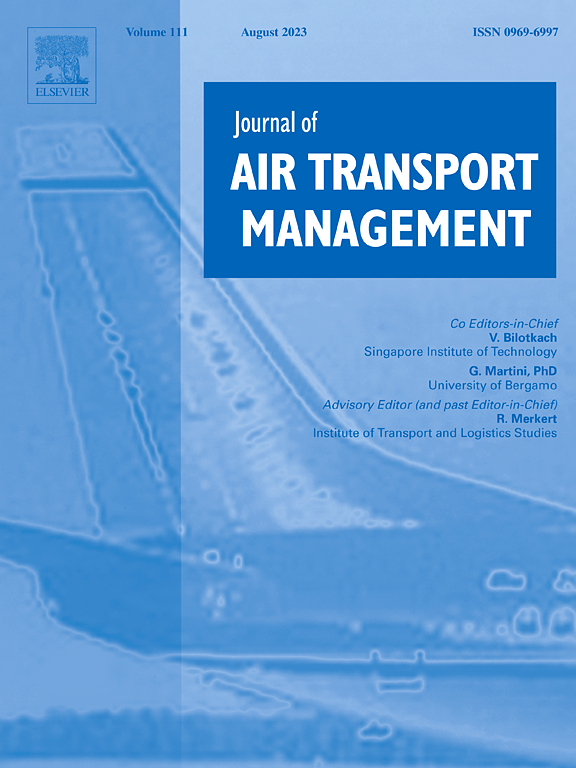中英里包裹递送框架的多目标垂直位置优化:南荷兰地区的案例研究
IF 3.6
2区 工程技术
Q2 TRANSPORTATION
引用次数: 0
摘要
随着城市化步伐的迅速加快和对高效交通方式的高需求,城市空中交通(UAM)市场在过去几年中出现了显着增长。货物运输尤其如此。使用UAM进行货物操作可能是通过在运营商网络中的设施或配送中心之间运输货物的中路交付(MMD)任务来实现的。这种网络的效率和实用性在很大程度上受到垂直机场战略位置选择的影响。针对目前科学研究中对垂直起降点位置优化的研究不足,本文旨在通过开发和分析考虑容量、可用土地空间、安全性和噪声影响因素的中程包裹投递系统垂直起降点位置多目标优化模型来填补这一研究空白。我们为MMD UAM网络开发了一种新的多目标多分配能力p-Hub覆盖问题框架,并以南荷兰地区为例进行了测试。值得注意的是,这种模式可以很容易地转换到其他城市。首先,为了减少计算量,提出了k均值聚类算法。这用于将6625个区域划分为若干K个集群,每个集群代表一个垂直端口候选位置。在此基础上,提出了一种基于禁忌搜索的多目标启发式优化算法。不同因素的影响,如集群数量、垂直机场数量、无人机航程、最大安全距离和返航时间。本文提出的模型为决策者提供了评估一个地区是否适合实施UAM MMD系统的能力,并有助于确定建立垂直机场的潜在良好地点。我们证明,垂直机场数量的增加导致更高的可实现需求覆盖,然而,这导致安全和噪音干扰性能方面的急剧下降。此外,结果表明,增加无人机范围,最大安全距离或减少周转时间允许整体性能更好的垂直飞行网络。本文章由计算机程序翻译,如有差异,请以英文原文为准。
Multi-objective vertiport location optimization for a middle-mile package delivery framework: Case study in the South Holland Region
With the rapidly increasing pace of urbanization and high demand for efficient modes of transport, the Urban Air Mobility (UAM) market has seen a remarkable growth in the past years. This is especially the case for the transportation of goods. Using UAM for cargo operations is likely through operating on Middle-Mile Delivery (MMD) missions to transport cargo between facilities or distribution centers in an operator’s network. The efficiency and practicality of such a network are largely affected by the selection of strategic positions for vertiports. As vertiport location optimization is underexplored in current scientific research this paper aims to fill this research gap by developing and analyzing a multi-objective optimization model for the placement of vertiports for a middle-mile package delivery system, considering capacity, available land space, safety and noise impact factors. We develop a novel Multi-Objective Multiple Allocation Capacitated p-Hub Coverage Problem framework for an MMD UAM network and test it using the South Holland region as a case study. Notably, the model can easily be converted to other cities. First, to reduce computational efforts, the K-means clustering algorithm is proposed. This is used to divide 6625 zones into a number of K clusters, with each cluster representing a vertiport candidate location. Furthermore, we present a multi-objective Tabu Search based heuristic optimization algorithm to solve the optimization problem. The impact of different factors such as number of clusters, number of vertiports, drone range, maximum safety distance, and turn around time The presented model provides decision-makers with the ability to assess the suitability of a region for the implementation of a UAM MMD system and aids in the identification of potential good locations to set up vertiports. We demonstrate that an increase in the number of vertiports leads to a higher attainable demand coverage, however, this results in a steep drop-off in terms of safety and noise nuisance performance. Furthermore, the results show that an increase in drone range, maximum safety distance or a decrease in turn around time allow for overall better performing vertiport networks.
求助全文
通过发布文献求助,成功后即可免费获取论文全文。
去求助
来源期刊

Journal of Air Transport Management
TRANSPORTATION-
CiteScore
12.40
自引率
11.70%
发文量
97
期刊介绍:
The Journal of Air Transport Management (JATM) sets out to address, through high quality research articles and authoritative commentary, the major economic, management and policy issues facing the air transport industry today. It offers practitioners and academics an international and dynamic forum for analysis and discussion of these issues, linking research and practice and stimulating interaction between the two. The refereed papers in the journal cover all the major sectors of the industry (airlines, airports, air traffic management) as well as related areas such as tourism management and logistics. Papers are blind reviewed, normally by two referees, chosen for their specialist knowledge. The journal provides independent, original and rigorous analysis in the areas of: • Policy, regulation and law • Strategy • Operations • Marketing • Economics and finance • Sustainability
 求助内容:
求助内容: 应助结果提醒方式:
应助结果提醒方式:


